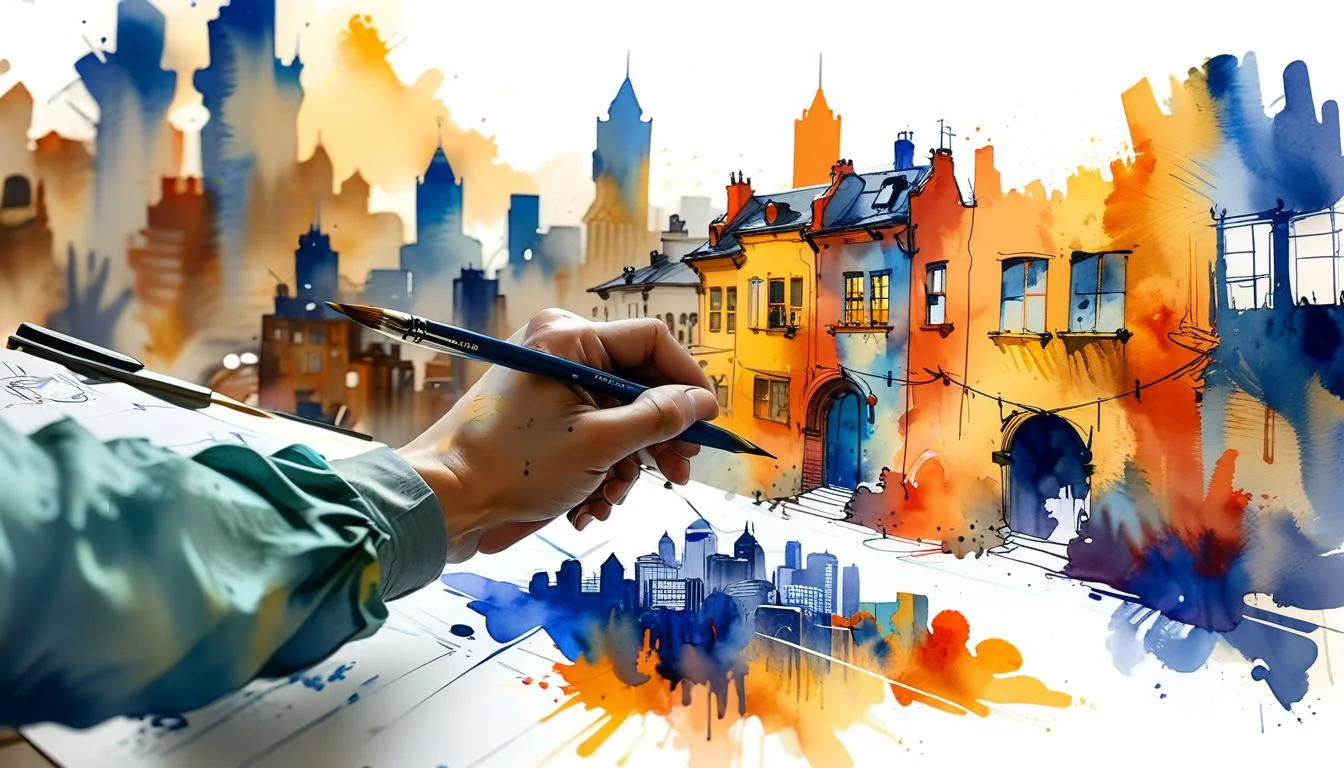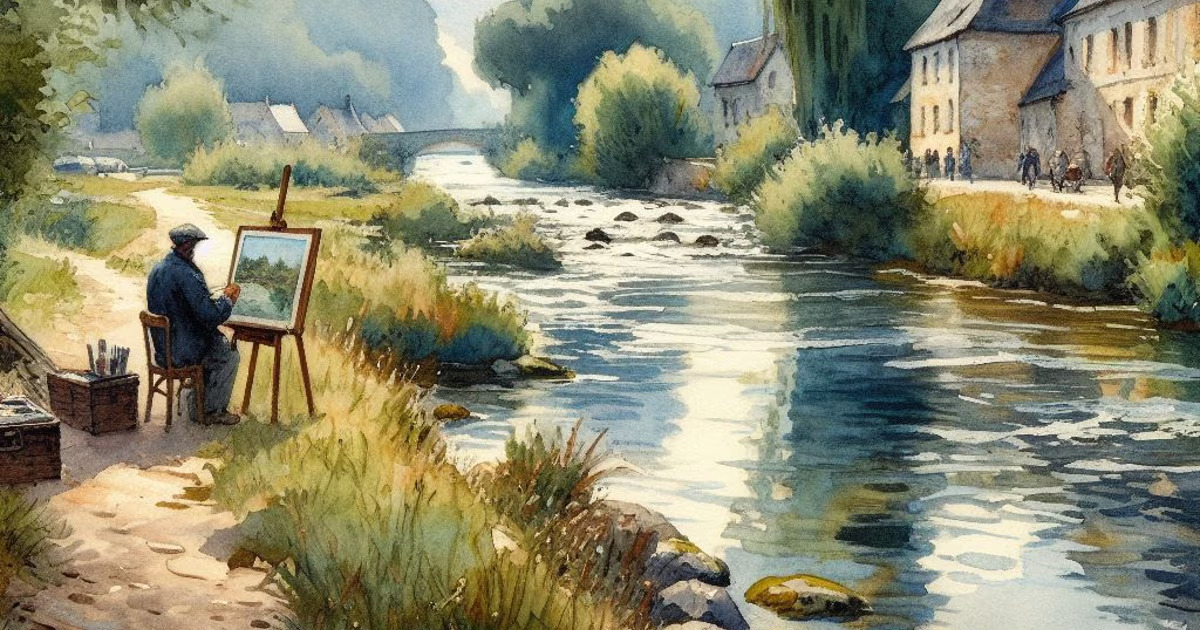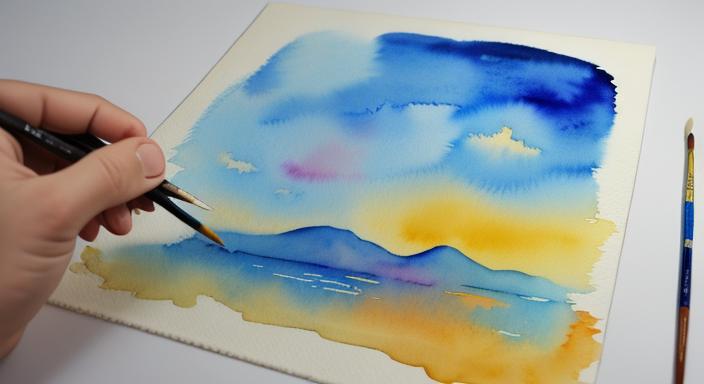Watercolor painting, with its translucent layers and fluid textures, is a medium that can beautifully capture the interplay of light and shadow. Mastering these elements is crucial for adding depth and realism to your work. In this article, we explore techniques and tips for effectively painting light and shadow in watercolor.
The Basics of Light and Shadow in Watercolor
Understanding Light Sources
To paint light and shadow convincingly, you must first understand your light source. Is it natural light streaming through a window, or artificial light from a lamp? The direction, intensity, and color of the light will affect how shadows are cast and how light interacts with different surfaces.
Types of Shadows
Shadows can be broadly categorized into two types:
- Cast Shadows: These are shadows thrown by an object onto another surface. They tend to have sharper edges and are darker where the light source is blocked completely.
- Form Shadows: These are shadows on the object itself where the light doesn’t reach. They are softer and more gradual in transition.
Masters of Shadow
Several artists have been recognized as masters of shadow in watercolor, known for their exceptional ability to depict light and shadow with finesse. Here are a few notable names:
- J.M.W. Turner: Often hailed as one of the greatest watercolorists, Turner’s work showcases dramatic light and shadow, particularly in his seascapes and landscapes. His use of subtle gradations and atmospheric effects made his paintings incredibly realistic and evocative.
- Winslow Homer: An American artist, Homer is renowned for his marine subjects and landscapes. His skillful use of light and shadow adds depth and a sense of realism to his work, making his watercolors vibrant and dynamic.
- John Singer Sargent: Though better known for his oil portraits, Sargent’s watercolors also display a mastery of light and shadow. His plein air paintings often capture fleeting moments of natural light, with shadows that bring his scenes to life.
- Anders Zorn: This Swedish painter is famous for his use of the limited “Zorn palette” and his masterful depiction of light. His watercolors, often of everyday scenes, are noted for their naturalistic shadows and luminous quality.
- Alvaro Castagnet: A contemporary watercolorist, Castagnet’s powerful use of contrast and bold shadows create compelling, atmospheric scenes. His dynamic compositions are a testament to his understanding of light and shadow.
- Joseph Zbukvic: Known for his urban landscapes and atmospheric scenes, Zbukvic’s watercolors are characterized by their dramatic light effects and the interplay of shadow. His ability to capture the essence of a scene with minimal strokes is widely admired.
Techniques for Painting Light and Shadow
Layering and Glazing
Watercolor is known for its layering capabilities. By applying multiple translucent layers (glazes), you can build up depth and create subtle shifts in tone and color.
- Glazing: Apply a light, transparent wash of color over a dried layer to alter its appearance without obscuring it. This technique is ideal for adjusting shadows and enhancing lighting effects.
Wet-on-Wet vs. Wet-on-Dry
- Wet-on-Wet: This technique involves applying wet paint onto a wet surface. It’s perfect for creating soft, diffused shadows and gentle transitions between light and dark.
- Wet-on-Dry: Apply wet paint onto a dry surface for more controlled and defined edges. This is useful for sharper shadows and highlights.
Shadow Techniques in Watercolor
Gradual Washes
To paint form shadows, use gradual washes. Start with a light tone and gradually add more pigment as you move away from the light source, creating a smooth gradient.
Dry Brush Technique
For textured shadows, use a dry brush technique. Load your brush with pigment but remove excess water. This technique works well for creating rough, textured surfaces like tree bark or fabric folds.
Negative Painting
Negative painting involves painting around an object to define it rather than painting the object itself. This technique is excellent for creating intricate details and adding contrast in watercolor painting.
Creating Contrast in Watercolor Painting
Contrast is essential for making your artwork pop. Here are some methods to create striking contrasts:
- Value Contrast: Use a wide range of values from light to dark. High contrast between light and shadow areas will make your painting more dynamic.
- Color Contrast: Contrast warm and cool colors to enhance the perception of depth. For example, a warm light against a cool shadow can create a vibrant effect.
- Edge Contrast: Hard edges between light and dark areas can draw attention, while soft edges can create a more subtle transition.
Realistic Lighting in Watercolor
Observing Real Life
The best way to understand light and shadow is to observe them in real life. Look at how light falls on different objects and the colors that emerge in the shadows.
Photographic References
Use photographs as references to study how light interacts with various surfaces. Pay attention to the way light diffuses, the colors in the shadows, and the intensity of highlights.
Depth in Watercolor Art
Atmospheric Perspective
To create a sense of depth, use atmospheric perspective. Objects further away should be lighter and less detailed, while closer objects are darker and more defined.
Overlapping Shapes
Overlapping shapes can also suggest depth. Ensure that shadows and highlights are consistent with the light source to maintain realism.
Watercolor Shading Tips
Tip 1: Pre-wet Your Paper
Pre-wetting your paper can help control the spread of paint and create smooth transitions. This is especially useful for large areas where you want a consistent gradient.
Tip 2: Use Masking Fluid
Masking fluid can protect areas of your paper that you want to keep white or light. This is useful for preserving highlights while you apply washes.
Tip 3: Test Colors and Values
Before applying paint to your artwork, test your colors and values on a scrap of paper. This can help you avoid unwanted surprises and ensure that your shadows and highlights are accurate.
First Steps
A Lesson from the Masters
The great watercolorist J.M.W. Turner often used light and shadow to dramatic effect. Turner’s seascapes, with their turbulent waves and stormy skies, are a masterclass in capturing the power of light. He often painted on location, observing the natural light and how it interacted with the landscape, which brought an unparalleled authenticity to his work.
The Struggle of a Beginner
I remember my early days of watercolor painting, struggling to create realistic shadows. My paintings looked flat and lacked depth. It wasn’t until I spent an afternoon in a local park, sketching and observing the way light filtered through the trees and cast shadows on the ground, that I began to understand how to translate these effects onto paper. That experience was a turning point in my journey as a watercolor artist.
Practical Exercises
To hone your skills in painting light and shadow, try these practical exercises:
Exercise 1: Still Life Study
Set up a simple still life with a single light source. Use objects with different textures and colors. Paint the still life, focusing on capturing the light source and the resulting shadows. Pay attention to the hardness of the edges and the color variations within the shadows.

Exercise 2: Outdoor Sketching
Find a spot with interesting lighting, such as a park or a café with outdoor seating. Spend time sketching the scene, noting how natural light creates form shadows and cast shadows. Try to capture the transient nature of light as it changes throughout the day.

Exercise 3: Monochromatic Studies
Use only one color to paint a scene, focusing solely on the values. This exercise helps you understand the importance of light and shadow without the distraction of color. It’s a great way to practice creating depth and contrast.

Common Mistakes and How to Avoid Them
Mistake 1: Ignoring the Light Source
Always determine where your light source is before you start painting. Inconsistent lighting can make your painting look unrealistic.
Mistake 2: Overworking the Shadows
Shadows should enhance the realism of your painting, not dominate it. Avoid using too many layers or too much pigment in shadow areas, which can make them look muddy.
Mistake 3: Flat Shadows
Shadows are rarely a single flat color. Incorporate a variety of hues and values to create more realistic and dynamic shadows.
Quotes from Artists
“Light is everything in watercolor painting. It’s what gives your work life and depth.” — Sarah Burns, watercolor artist
“The interplay of light and shadow is like a dance, and mastering it is key to creating compelling art.” — David Taylor, watercolorist
Tools and Materials
Here are some recommended tools and materials for painting light and shadow in watercolor:
| Tool | Description |
|---|---|
| Quality Watercolor Paper | Choose paper with good weight (140 lb or more) and texture (cold-pressed or rough) for best results. |
| Variety of Brushes | Use different brush sizes and types (round, flat, detail) to achieve various effects. |
| Masking Fluid | Protect areas that need to remain white or light while you paint the surrounding areas. |
| Palette with Multiple Wells | Helps in mixing a variety of shades and tints for more nuanced shadows and highlights. |
| Light Box or Natural Light Source | Essential for studying and understanding how light interacts with objects. |
Conclusion
Mastering the art of painting light and shadow in watercolor is a journey that requires observation, practice, and patience. By understanding how light behaves and utilizing various techniques, you can create paintings that are not only visually stunning but also imbued with a sense of realism and depth. Remember, the key lies in subtlety and the delicate balance of light and dark. So, pick up your brush and start experimenting with watercolor lighting effects and shadow techniques to bring your artwork to life.
By embracing these principles and continually practicing, you’ll develop a keen eye for detail and an intuitive understanding of how to manipulate light and shadow to enhance your watercolor paintings. Whether you’re a beginner or an experienced artist, there’s always more to learn and discover in the beautiful dance of light and shadow.


